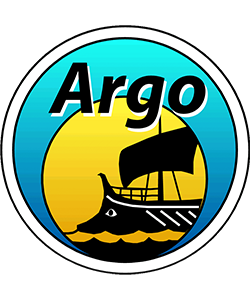Sometimes accessing and decoding the freely available Argo data files in NetCDF format can be difficult (see the quick start guide to get started) for those not familiar with the format or how to use the data. While there are existent data viewers like Ocean Data View (ODV) and Java Ocean Atlas (JOA) that can read in Argo profile data, several visualizations and web applications have been developed to help a wide range of users access and view Argo data. Browse through the table below to learn more about the available options. If you have a way to visualize Argo data that you would like added to the table below, email argo@ucsd.edu.
Compare visualization features here
| Visualization | Description | Target Audience | Region |
| Argovis | Visualize temperature, salinity, and BGC data by location at argovis.colorado.edu or access data via an API. View float trajectory forecasts, compare gridded fields with Argovis’ grid visualization module or co-locate Argo data with Atmospheric Rivers. Stay tuned for additional modules using satellite and other Earth science datasets. See the Argovis quickstart page for more information on its features. | Public, educators, Argo community, scientific community | global |
| EuroArgo Selection Tool | The EuroArgo Selection Tool provides an interactive map interface that allows users to click on individual float locations and to make regional selections. There are also options to select what parameters users would like, the data quality mode and time period of interest. Users can select to download the data chosen in csv, Argo netCDF or Copernicus netCDF format. | Public, educators, Argo community, scientific community | global |
| OceanOPS Dashboard | Get technical with the site used frequently by the Argo community, OceanOPS Dashboard. Click on a float to pull up metadata, technical information and access to float data. There are many search options including by mission, program, transmission system, sensor, etc. Make plots or look at performance indicators based on your selection or view static maps and indicators produced monthly. Includes data figures produced by Ifremer and shown on several other visualizations | Argo community, governmental agencies | global |
| Global Marine Argo Atlas | The Global Marine Argo Atlas makes it easy for users to look at Argo data and compare it to other global data sets in one free program. The Atlas, made to view gridded netCDF datasets, particularly Argo, Reynolds SST and Aviso altimetry, comes with the data already included and can be updated quarterly to receive new data as it becomes available. Note: the Atlas must be downloaded and the large dataset takes up a few GBs. The Windows version uses an old version of the graphing program and no longer has full capability for some difficult computations. Please consider Argovis’s gridded module instead. | Public, educators, Argo community, scientific community | global |
| Mon Océan et moi website | Mon ocean et moi (My Ocean and Me) & Adopt a Float are France-based educational projects designed specifically to raise students awareness of ocean science and help students follow floats in the ocean. Explore the interactive map showing BGC Argo float locations and figures of BGC Argo data. | Public & educators | global |
| EuroArgo Dashboard | The Euro-Argo dashboard provides an interactive map interface that features metadata and technical data used mostly by the Argo community, but also float locations, trajectories and figures. It is the only site that tracks float battery life and other technical aspects of floats, making it an excellent tool to monitor the health of the Argo fleet. Includes data figures produced by Ifremer and shown on several other visualizations | Argo community | global |
| Earth.nullschool.net | If you want to see how ocean currents move in real time across the globe, check out Earth Null School. Used by classrooms to study weather and climate, this data viz site now has a beta version of Argo data available at this link. Note: this is a beta version with limited Argo data. | Public & educators | global |
| Argo Google Earth Layer | Monitor the Argo network in real-time using Google Earth software (GE). This Argo layer for Google Earth shows the positions of all active and inactive floats, features stories about a select number of floats and shows where floats will be deployed. Includes data figures produced by Ifremer and shown on several other visualizations. Note: it is no longer well supported. Please consider Argovis, EuroArgo Dashboard or OceanOPS instead. | Public, educators, Argo community, governmental agencies | global |
| Indian Argo Tableau | Get a dashboard view of the spatial distribution, DAC distribution and status of Argo floats using Indian Argo Tableau. | Argo community | global |
| Ocean Navigator | Compare model results that use Argo data on the Canada OceanNavigator. Stay tuned as this site develops a tool to compare real observations to model data. | Scientific community | Northern hemisphere |
